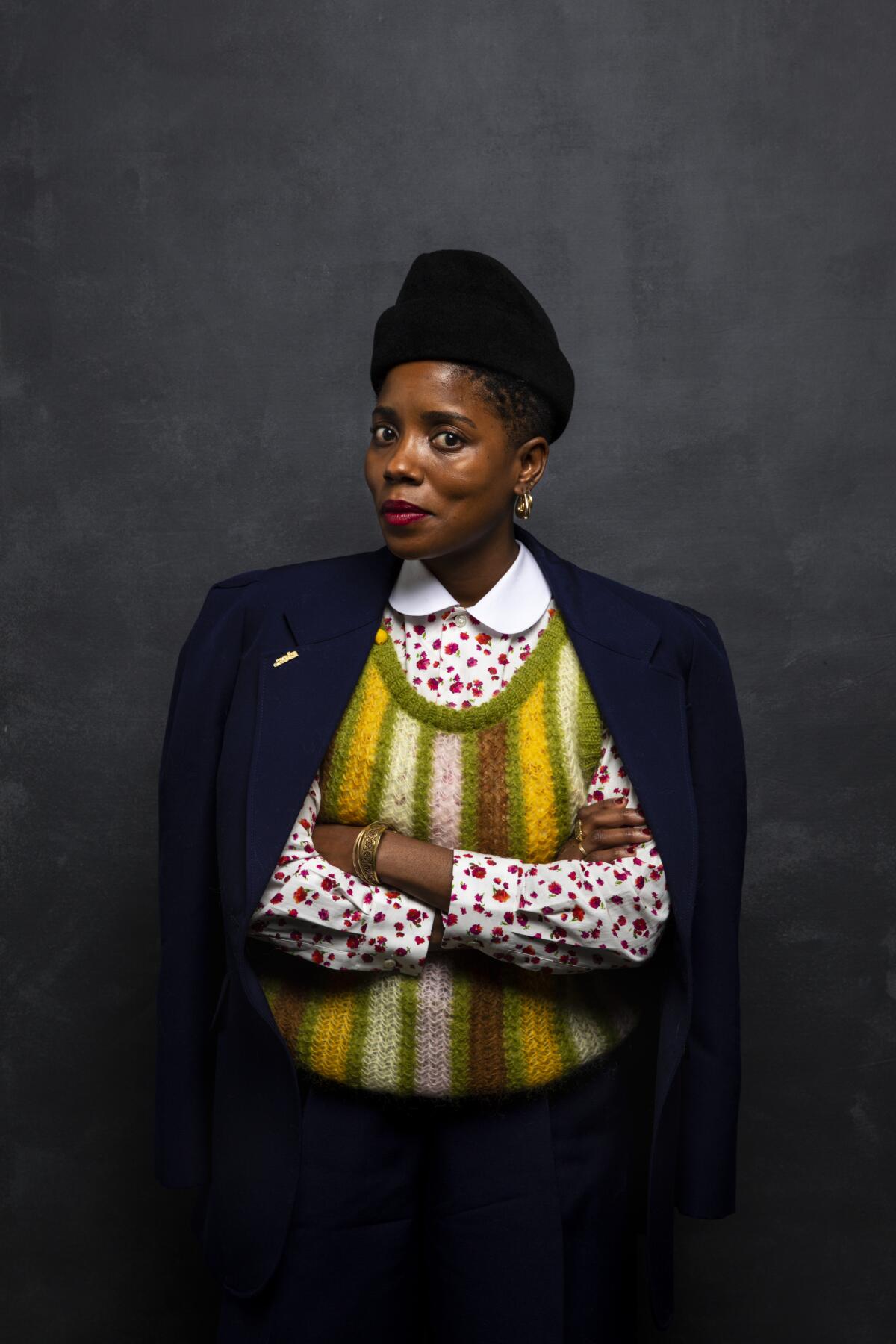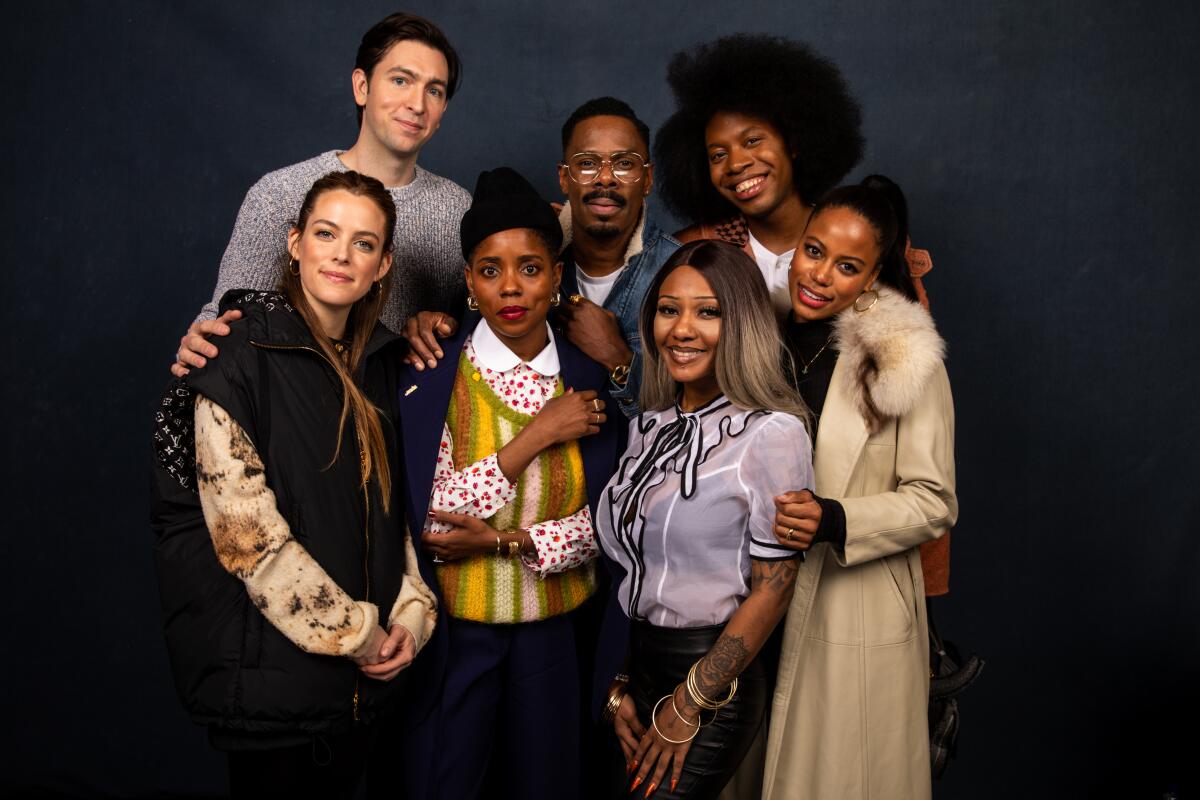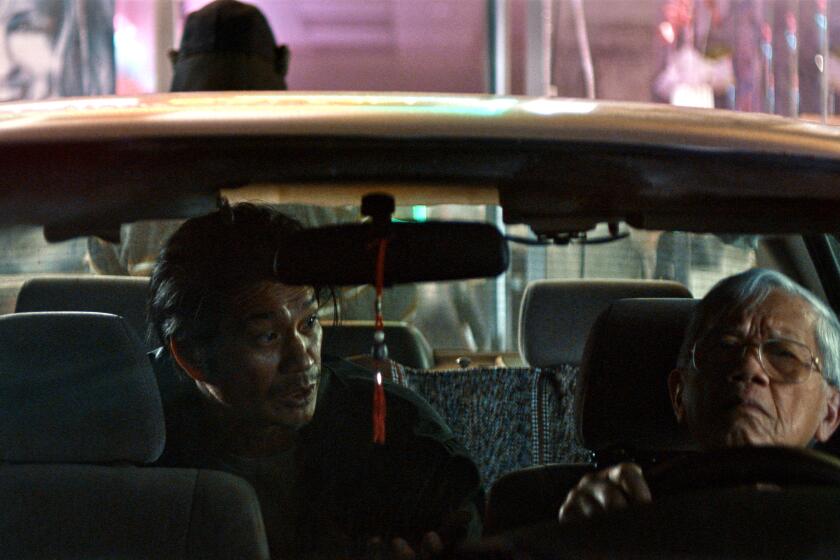Janicza Bravo knew she had to make ‘Zola.’ Here’s how she made it happen

- Share via
The new film “Zola” hits like a lightning bolt, with a chaotic energy that is equally uproarious and unnerving. The complicated comedy is based on the 2015 story told in 148 tweets by A’Ziah “Zola” King that began with these attention-grabbing lines: “Y’all wanna hear a story about why me & this bitch here fell out??????? It’s kind of long but full of suspense.”
Those words proved to be an understatement. The tale is a kaleidoscopic roller-coaster of sex work, deception, violence, manipulation and survival. As told in the movie, a waitress and dancer named Zola (Taylour Paige) is persuaded by a woman she just met named Stefani (Riley Keough) to go on a road trip to Florida to make money stripping. The two men who travel with them turn out to be Stefani’s boyfriend (Nicholas Braun) and her pimp (Colman Domingo). Zola eventually learns she is also expected to have sex for money.
With a stylized garishness, the film is at times outrageously funny and at other moments stark and disturbing — sometimes in the same scene — and is very much the work of director and co-writer Janicza Bravo.
After a series of acclaimed short films, Bravo made her feature debut with 2017’s comedy of awkward privilege “Lemon,” which, like “Zola,” launched at the Sundance Film Festival. She subsequently directed episodes of “Atlanta” and “Mrs. America” for FX and the current season of HBO’s “In Treatment.”
Bravo co-wrote the screenplay with playwright Jeremy O. Harris. Now known as the writer of “Slave Play,” which broke a record for most Tony nominations for a non-musical play, Harris was still a student at Yale when they began working together on the adaptation.
“So I am responsible actually for why ‘Slave Play’ exists,” Bravo said playfully during a recent interview for “The Envelope” podcast. “I feel a lot of people should be thanking me for that.”
Below are edited excerpts from that conversation.
Even though the movie premiered at Sundance in January 2020 and saw its release delayed by the pandemic, it still feels as provocative, outrageous and, frankly, dangerous as it did then. In waiting for the movie to come out and with all that’s happened since then, are you surprised that the energy of the movie is the same?
Yes and no. I think that the content of the work itself feels very alive and very young and it has a kind of of-the-moment quality. That’s not to say that I think in five or 10 years that it wouldn’t feel as electric as it does right now, but it is a film that is literally born out of the internet. Our source material is a Twitter thread, and there is an audience out there that has been dying for this movie.
There was something really exciting about finally being able to have this moment, and I would say with the film one of our top notes is agency and freedom of expression. And so I think one of the reasons it might feel so great for right now is that the world of the film is pretty radical. The women in the movie are radical. That a Twitter story was turned into a film is radical. There is so much expression and none of that expression is asking for permission. And I think that all of that just feels like it’s bubbling right now, it’s ready to explode. And I feel after a year-plus indoors, all I want is to breathe, and I imagine a lot of us out there want that.
Before you came to the project, there was another director and another script attached. As I understand it, you worked really hard to get this job. What was important about this story to you and why did it really matter that you be the director for this movie?
I read the story initially on Twitter, I think it was the end of that day. As I was wrapping up, I was on a group thread with a few Black girlfriends. They had sent it and they’d been interacting with it as it was coming out. And that night I was in bed and I was halfway through it, three-quarters of the way through it, and this may sound kind of goofy, but I just knew, “Oh, I’m supposed to direct this, I’m going to make it, I should direct it.” And I didn’t have a ton of thoughts that went into it. It just was like, “You’re directing this. This is your next movie.”
I wanted to go after it because ... one, it’s super funny. Whenever I have described the movie to people as “A dark comedy, two women go on a road trip to make money stripping and then one’s kind of sold into sex slavery and she has to get out of it. But it’s really funny,” most people don’t see how that’s funny. If it were a not funny movie about sex work and sex trafficking, I don’t think that I would be the right director for it. But A’Ziah King, who wrote this story, had imbued it with so much dark humor — you’re laughing at some of the most disturbed moments. There is a woman who 20 men are paying to have sex with and then she has a joke in there. And it doesn’t really make any sense, but it just is.
I found myself feeling like this is exactly how I would tell this — her way of exorcizing her trauma, her way of processing trauma, it feels so familiar to me. I feel so close to it. This is how I move through the world. And I think the thing that kind of pulled me to it was I want to protect this story, I want to protect the thing that she told and I’m ready to be on that ride. And whatever it takes, I’m going to do it. And I think I’m the best director for that because I don’t mind how long things take, I’m comfortable with how long they take, I’m comfortable with how crunchy they can be, I’m comfortable with how painful and emotional and depressing. And so I thought, “I can do this. I can protect this woman. I know this story is really special and I’ve got the guts to do it.”
When you say protect her story, what do you what do you mean by that? What are you protecting?
I think there is a version of this story that has a little less care and attention to detail. There is a real tight rope that happens. And like I said, it is also about sex slavery. It is also about sex work. And I think there is plenty of work around these spaces that can be a little bit dark, a little bit distant — sometimes the filmmaking can feel a bit like how the other half lives.
And also because her story is super fun, it is a real ride, I think there is also a version of this piece that isn’t engaging with the seriousness and the weight of what she is also talking about. And I felt my own relationship to my own work and how I was weaving humor and stress and anxiety and discomfort really could apply here. And I wanted to make sure that, yes, we could make a movie that was fun. Yes, we can make a movie that felt like a f— party, but that also we were talking about something and that the women whose lives we were adding dimension to, that we were giving them dignity.

You were working on the screenplay with Jeremy O. Harris before he wrote “Slave Play,” and it feels like the work is similarly purposefully designed to explore how Black audiences and white audiences are going to respond differently. Is that something that you wanted to be a part of “Zola?”
Absolutely. I actively considered it when working on the adaptation, but whether or not I was active in how I approached it, it was already there. The story is so much about race. It is a Black woman telling a story about how her and a white woman fall out. So whether or not you want it to be about race, it just is because these two individuals move through the world differently. They’re looked at differently. They’re cared for differently.
And you’re actually speaking to when I first read it in 2015, I had done a little dramaturgical research and the handful of articles I came across all did a couple of things that really stuck with me. She was 19 and a lot of the pieces either removed her age or made her older, 22, 24, 25. And I think there was this conscious or unconscious move to adultize her so as to strip her of whatever it is we imbue to young people — the gentility that we would inherently give to a young person or a girl. If you make her [twentysomething] then she doesn’t deserve our care.
The other thing I noticed that was pretty much in every piece that was written was [a questioning of] the validity of her story. Not so much the events, but the validity of it. And I thought it’s possible that a lot of this isn’t true, but these events are pretty bleak. I’m not sure why we’re not talking about that. Here’s an opportunity for us to talk about forgotten girls, lost girls — and rather than that be where the discourse went, it went to whether or not her story was true.
I felt like that meant that a Black audience was going to show up to this a little different and a white audience would also show up to this a little bit different. And also age range, all of that. For every person, there was going to be this individual experience of how they met these two women and the thing that happens to them and between them.
One of my favorite moments in the movie happens while they’re on the drive to Florida. Zola and Stefani go to the bathroom together and you put the camera above them and it glides back and forth between two stalls. And we learn a lot about the two of them and their personalities just from how they use the bathroom. It’s mostly visual storytelling, from their performance, there’s not really a lot of dialogue and it’s not something that came from the tweets. Where does a moment like that come from?
I really wanted this scene on bathroom behavior. I was remembering my first time away from home was when I went to college. And one of my first memories of being out with my girlfriends, most of them white, was getting drunk off of Long Island iced teas and going to a bathroom in a bar and both being in the same stall and me going to the bathroom the way my mother taught me how to use a public bathroom, which was to hang my bottom above the seat and not actually sit, really rely on my knees and my thighs, and wipe the seat after me. And many of my girlfriends sat on the toilet. I had never seen that before.
I mean, I’d also never been alone in a bathroom with someone that I didn’t know, or someone that wasn’t my family. And so it seemed so foreign to me because my mother had ingrained in me that wasn’t OK — for a multitude of reasons, probably germs, disease, things like that. It was so wild to me that there was this ease with which some of my girlfriends moved through the world. And once I had the movie, I thought, “Oh, I have to tell that story.” It’s so much about me, but it’s about how I related to my white girlfriends, how we were together. If I were to distill one scene from the film and be asked, what do you think is the movie, that would be the scene that I would extract. It says so much about who they are and how they move through the world.
More to Read
Only good movies
Get the Indie Focus newsletter, Mark Olsen's weekly guide to the world of cinema.
You may occasionally receive promotional content from the Los Angeles Times.











